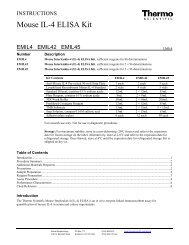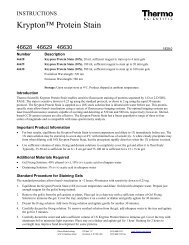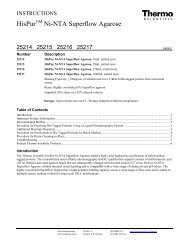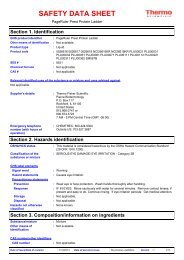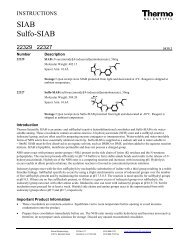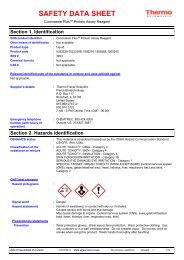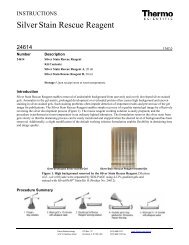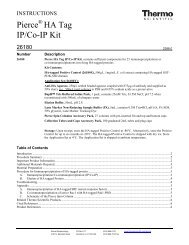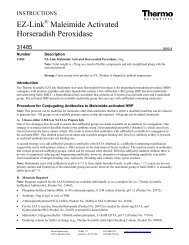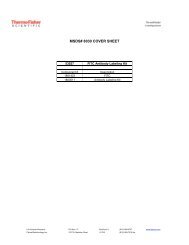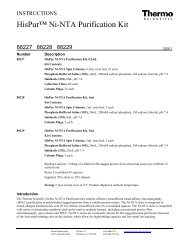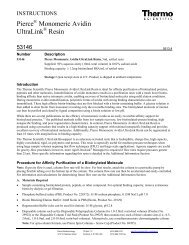EZ-Link NHS-PEG Solid Phase Biotinylation Kit â Pre ... - Pierce
EZ-Link NHS-PEG Solid Phase Biotinylation Kit â Pre ... - Pierce
EZ-Link NHS-PEG Solid Phase Biotinylation Kit â Pre ... - Pierce
You also want an ePaper? Increase the reach of your titles
YUMPU automatically turns print PDFs into web optimized ePapers that Google loves.
INSTRUCTIONS<br />
<strong>EZ</strong>-<strong>Link</strong> ® <strong>NHS</strong>-<strong>PEG</strong> <strong>Solid</strong> <strong>Phase</strong><br />
<strong>Biotinylation</strong> <strong>Kit</strong> − <strong>Pre</strong>-packed Column<br />
21440<br />
1473.2<br />
Number Description<br />
21440 <strong>EZ</strong>-<strong>Link</strong> <strong>NHS</strong>-<strong>PEG</strong> <strong>Solid</strong> <strong>Phase</strong> <strong>Biotinylation</strong> <strong>Kit</strong> − <strong>Pre</strong>-packed Column, contains sufficient<br />
material for eight biotinylation reactions each consisting of 1-10mg of IgG<br />
<strong>Kit</strong> Contents:<br />
Immobilized Nickel Chelated Column, 1mL<br />
Binding capacity: >10mg human IgG<br />
<strong>NHS</strong>-<strong>PEG</strong> 4 -Biotin, No-Weigh Format, 8 × 2mg microtubes<br />
Molecular Weight: 588.67<br />
Spacer Arm Length: 29Å<br />
BupH Phosphate Buffered Saline Pack, 1 each<br />
4M Imidazole Stock Solution, 5mL<br />
Storage: Upon receipt store at 4°C. Product is shipped at ambient temperature.<br />
Table of Contents<br />
Introduction .................................................................................................................................................................................1<br />
Important Product Information ....................................................................................................................................................2<br />
Additional Materials Required.....................................................................................................................................................2<br />
Material <strong>Pre</strong>paration ....................................................................................................................................................................2<br />
Procedure for <strong>Solid</strong>-<strong>Phase</strong> <strong>Biotinylation</strong>......................................................................................................................................3<br />
A. Antibody Binding ..........................................................................................................................................................3<br />
B. Antibody <strong>Biotinylation</strong>..................................................................................................................................................3<br />
C. Antibody Elution ...........................................................................................................................................................3<br />
Troubleshooting...........................................................................................................................................................................3<br />
Appendix .....................................................................................................................................................................................4<br />
Related Thermo Scientific Products ............................................................................................................................................4<br />
Cited References..........................................................................................................................................................................4<br />
Introduction<br />
The Thermo Scientific <strong>EZ</strong>-<strong>Link</strong> <strong>NHS</strong>-<strong>PEG</strong> <strong>Solid</strong> <strong>Phase</strong> <strong>Biotinylation</strong> <strong>Kit</strong> allows for efficient biotinylation of purified IgG<br />
class antibodies. This solid-phase biotinylation method uses nickel-chelated agarose to first immobilize purified IgG. The<br />
antibody is then biotinylated by adding a solution of <strong>NHS</strong>-<strong>PEG</strong> 4 -Biotin. Excess biotin is washed from the column, and the<br />
antibody is eluted in a buffered imidazole solution. The reaction results in approximately 3-5 biotin molecules per antibody<br />
molecule. Although this solid-phase format has been optimized using human IgG, it may be used with other mammalian<br />
antibodies. The nickel-chelated agarose binds IgG through a histidine-rich cluster on the Fc region at the junctures of the Cγ2<br />
and Cγ3 domains that is highly conserved among all mammalian IgGs. 1-4 Purified IgG from sheep, mouse, goat, rat and rabbit<br />
will bind to nickel-chelated resin.<br />
This kit includes <strong>NHS</strong>-<strong>PEG</strong> 4 -Biotin packaged in the convenient pre-measured No-Weigh Microtube Format, eliminating<br />
difficulties associated with weighing small quantities of reagent. <strong>NHS</strong>-<strong>PEG</strong> 4 -Biotin (see Figure 1 in Appendix A for<br />
molecular structure) reacts with primary amines, primarily ε-amine groups on available lysine residues. The N-<br />
hydroxysuccinimide (<strong>NHS</strong>) ester reacts with amines by nucleophilic attack, forming an amide bond and releasing the <strong>NHS</strong>.<br />
The resulting biotinylated antibody retains biological activity because biotin is a relatively small molecule. An antibody<br />
conjugated with several biotin molecules can each bind one molecule of avidin, thereby increasing the sensitivity of many<br />
<strong>Pierce</strong> Biotechnology PO Box 117 (815) 968-0747 www.thermoscientific.com/pierce<br />
3747 N. Meridian Road Rockford, lL 61105 USA (815) 968-7316 fax
assays. The bond formation between biotin and avidin is rapid and, once formed, is unaffected by most extremes of pH,<br />
organic solvents and other denaturing agents. 5 The hydrophilic polyethylene glycol (<strong>PEG</strong>) spacer arm of <strong>NHS</strong>-<strong>PEG</strong> 4 -Biotin<br />
imparts water solubility that is transferred to the biotinylated antibody, thus <strong>NHS</strong>-<strong>PEG</strong> 4 -Biotin reduces aggregation of labeled<br />
antibodies stored in solution. 6<br />
This solid-phase method is advantageous compared with solution-phase protocols as it facilitates reagent delivery and<br />
removal of spent product and there is more control over reaction conditions. Although the time required for completion of the<br />
protocol is comparable to solution-phase protocols, antibody immobilization eliminates the need for desalting or dialysis to<br />
remove excess biotin, resulting in excellent antibody recovery.<br />
Important Product Information<br />
• Use this kit only with purified IgG. Antibodies in serum or ascites must be purified before using this kit. Do not use this<br />
kit for IgM or IgY, Fab, or antibody fragments that do not contain a Fc region, as they do not bind efficiently to the<br />
nickel-chelated agarose.<br />
• This protocol has been optimized for 1-10mg of antibody. The antibody preparation must be free of chelating agents<br />
such as EDTA and EGTA.<br />
• BSA (bovine serum albumin) is often added to commercial antibody preparations as a stabilizer and is present in molar<br />
excess to the antibody. BSA will decrease specific biotinylation because it contains available histidine residues and binds<br />
to the nickel-chelated agarose and is then biotinylated and eluted along with the antibody. Remove BSA before using this<br />
kit. BSA removal is a fast and simple process; see Appendix B for suggested albumin removal products.<br />
Note: Although gelatin, which often is also added to antibody preparations, will bind to the nickel-chelated agarose, it is<br />
present in low amounts (usually ~0.2%) and will not significantly affect yields.<br />
• Use reconstituted No-Weigh <strong>NHS</strong>-<strong>PEG</strong> 4 -Biotin immediately. The <strong>NHS</strong>-ester moiety readily hydrolyzes and becomes<br />
nonreactive; therefore, solutions cannot be prepared for storage. Discard any unused reconstituted reagent.<br />
• The degree of biotinylation can be determined by performing the HABA assay (Product No. 28005); however, 0.2M<br />
imidazole (Elution Buffer) interferes with the HABA assay. Dilute on-column biotinylated IgG 1:1 with PBS before use<br />
in the HABA assay to reduce imidazole concentration to 0.1M.<br />
• Protein assays can be used to determine concentration of eluted IgG. When determining concentration of IgG in Elution<br />
Buffer, use the Thermo Scientific Coomassie Plus (Bradford) Protein Assay Reagent (Product No. 23236). The Thermo<br />
Scientific <strong>Pierce</strong> BCA Protein Assay cannot be used because imidazole interferes with the assay chemistry.<br />
• When properly washed and stored, the nickel-chelated column can be re-used up to 10 times without significant loss of<br />
binding capacity.<br />
Additional Materials Required<br />
• 0.2 μm, 500mL filter sterilization unit<br />
• Test tubes and test tube rack<br />
Material <strong>Pre</strong>paration<br />
Phosphate Buffered Saline<br />
(PBS)<br />
Elution Buffer<br />
Reconstitute contents of the phosphate-buffered saline (PBS) pack with 500mL ultrapure<br />
water. Filter-sterilize solution using a 0.2μm filter apparatus and store at 4°C. When stored<br />
properly, there is sufficient buffer for eight antibody biotinylation reactions of up to 10mg of<br />
IgG each.<br />
<strong>Pre</strong>pare 6mL of Elution Buffer by diluting 300μL of the 4M Imidazole Stock Solution with<br />
5.7mL of PBS.<br />
Antibody Binding Solution Dilute purified IgG to be biotinylated (1-10mg) with PBS to a volume of 6mL. If the antibody<br />
concentration is too dilute to make a 6mL binding solution, dilute the antibody 1:1 with PBS<br />
and apply the entire volume of Antibody Binding Solution to the column. Any volume may be<br />
applied provided the total amount of IgG is ≤ 10mg.<br />
<strong>Pierce</strong> Biotechnology PO Box 117 (815) 968-0747 www.thermoscientific.com/pierce<br />
3747 N. Meridian Road Rockford, lL 61105 USA (815) 968-7316 fax<br />
2
Procedure for <strong>Solid</strong>-<strong>Phase</strong> <strong>Biotinylation</strong><br />
A. Antibody Binding<br />
The antibody must be purified. If BSA is present in the antibody preparation, remove it before using this kit. See Appendix B<br />
for a list of suggested purification products.<br />
1. Equilibrate Nickel-Chelated Column and PBS to room temperature before use.<br />
2. To avoid introducing air bubbles into the column, open a Nickel-Chelated Column by first removing the top cap. Discard<br />
the storage solution (contains 0.01% sodium azide). Remove the column’s bottom cap. Place column in a test tube.<br />
3. Equilibrate column by adding 15mL of PBS and allowing the solution to drain through the column.<br />
4. Apply the Antibody Binding Solution to the column and allow it to flow completely into the nickel-chelated resin. The<br />
column will stop flowing when the liquid level reaches the top disc.<br />
5. Wash the column with 12mL PBS.<br />
B. Antibody <strong>Biotinylation</strong><br />
1. Puncture the seal of one <strong>NHS</strong>-<strong>PEG</strong> 4 -Biotin microtube with a pipette tip and dissolve tube contents in 200μL of PBS.<br />
Solubilize contents by gently pipetting up and down.<br />
2. In a new test tube, make the appropriate <strong>NHS</strong>-<strong>PEG</strong> 4 -Biotin solution for the amount of antibody being biotinylated as<br />
indicated in Table 1. Add PBS to the test tube first, and then add the biotinylation reagent.<br />
Table 1. <strong>NHS</strong>-<strong>PEG</strong> 4 -Biotin solution preparation.<br />
Antibody<br />
Amount (mg)<br />
PBS<br />
Volume (mL)<br />
Biotin<br />
Volume (μL)<br />
Biotin Final<br />
Molarity (mM)<br />
1-2.5 3 88 0.5<br />
2.6-4.5 3 141 0.8<br />
4.6-5.9 3 200 1.1<br />
6-7.5 2 200 1.7<br />
7.6-10 1.5 200 2.5<br />
3. Apply the biotin solution to the column.<br />
4. After the solution has flowed completely through the nickel-chelated resin, cap the bottom and then the top of the<br />
column. Incubate for 30 minutes at room temperature.<br />
5. After incubation, sequentially remove the top and bottom caps from the column. Wash the column with 15mL of PBS.<br />
C. Antibody Elution<br />
1. Place column in a new test tube. Add 3mL Elution Buffer to the column. Collect biotinylated antibody.<br />
Note: Biotinylated antibodies are generally stable when stored in Elution Buffer (0.2M imidazole in PBS) at 4°C;<br />
however, stability is antibody-specific. Store biotinylated antibodies at -20°C if they will not be used within one month.<br />
2. Regenerate the column by adding 3mL Elution Buffer.<br />
3. For storage, wash the column with 15mL water containing 0.02% sodium azide. When approximately 3mL of solution<br />
remains above the top disc, replace the bottom cap followed by the top cap on the column and store upright at 4°C.<br />
When properly washed and stored, the column can be re-used up to 10 times without significant loss of binding capacity.<br />
Troubleshooting<br />
Problem Cause Solution<br />
Antibody did not bind to<br />
column<br />
Fab fragments, IgM or IgY were used<br />
BSA was present in antibody preparation<br />
Do not use antibodies without an Fc region, or<br />
IgM or IgY with this kit<br />
Remove BSA before using this kit<br />
Antibody was not<br />
biotinylated<br />
<strong>NHS</strong>-<strong>PEG</strong> 4 -Biotin hydrolyzed before use Reconstitute <strong>NHS</strong>-<strong>PEG</strong> 4 -Biotin immediately<br />
before use and always use a new tube of<br />
biotinylation reagent for each reaction<br />
<strong>Pierce</strong> Biotechnology PO Box 117 (815) 968-0747 www.thermoscientific.com/pierce<br />
3747 N. Meridian Road Rockford, lL 61105 USA (815) 968-7316 fax<br />
3
Appendix<br />
A. Structure of <strong>NHS</strong>-<strong>PEG</strong> 4 -Biotin<br />
The <strong>NHS</strong> ester of <strong>NHS</strong>-<strong>PEG</strong> 4 -Biotin reacts with amines by<br />
nucleophilic attack forming an amide bond. The hydrophilic<br />
polyethylene glycol (<strong>PEG</strong>) spacer arm (29Å) imparts water<br />
solubility that is transferred to the biotinylated antibody,<br />
thus <strong>NHS</strong>-<strong>PEG</strong> 4 -Biotin reduces aggregation of labeled<br />
antibodies stored in solution.<br />
O<br />
O<br />
N<br />
O<br />
O<br />
O<br />
O<br />
O<br />
29 Å<br />
O<br />
H<br />
N<br />
O<br />
HN<br />
O<br />
S<br />
NH<br />
B. Bovine Serum Albumin (BSA) Removal<br />
Two methods exist for removing BSA and/or gelatin from antibody preparations. The first is to affinity purify the antibody<br />
using immobilized Proteins A, G or L. Antibody will bind to the immobilized protein, allowing BSA to be removed by<br />
washing. The antibody is eluted and the solution is adjusted to a neutral pH (according to the protocol). Dilute the eluted<br />
antibody 1:1 with PBS before adding to the immobilized protein. For more information about Protein A, G, and L binding<br />
characteristics, see the catalog or Tech Tip #34 from our website.<br />
The second method is to use Thermo Scientific Melon Gel Resin (e.g., Product No. 45206), which will bind to the BSA and<br />
gelatin and allow the purified antibody to be recovered in the flow-through. For more information about Melon Gel<br />
Products and this method of removal, see Tech Tip #55 from our website.<br />
Related Thermo Scientific Products<br />
28005 Biotin Quantitation <strong>Kit</strong><br />
23236 Coomassie Plus (Bradford) Protein Assay<br />
21126 Streptavidin, Horseradish Peroxidase Conjugated, 1mg<br />
21324 Streptavidin, Alkaline Phosphatase Conjugated, 1mg<br />
15120 <strong>Pierce</strong> Streptavidin Coated Plates, 5 plates (see catalog for a complete listing of plates)<br />
Cited References<br />
1. Hale, J. and Beidler, D. (1994). Purification of humanized murine and murine monoclonal antibodies using immobilized metal-affinity<br />
chromatography. Anal. Biochem. 222(1):29-33.<br />
2. Diesenhoefer, J., et al. (1978). Crystallisation, crystal structure analysis and atomic model of the complex formed by a human Fc fragment and<br />
fragment B of protein A from Staphylococcus aureus. Hoppe-Seyler’s Z. Physiol. Chem. 359:975-979.<br />
3. Burton, D. (1985). Immunoglobulin G: functional sites. Mol. Immunol. 22(3):161-206.<br />
4. Kabat, E., et al. (1987). Sequences of Proteins of Immunological Interest. United States Department of Health and Human Services, National Institutes<br />
of Health, Bethesda, MD.<br />
5. Green, N.M. (1975). Avidin. In Adv. In Protein Chemistry. Academic <strong>Pre</strong>ss, New York 29:85-133.<br />
6. <strong>Pierce</strong> <strong>Pre</strong>views, 2001. Volume 5, Issue 2.<br />
This product (“Product”) is warranted to operate or perform substantially in conformance with published Product specifications in effect at the time of sale,<br />
as set forth in the Product documentation, specifications and/or accompanying package inserts (“Documentation”) and to be free from defects in material and<br />
workmanship. Unless otherwise expressly authorized in writing, Products are supplied for research use only. No claim of suitability for use in applications<br />
regulated by FDA is made. The warranty provided herein is valid only when used by properly trained individuals. Unless otherwise stated in the<br />
Documentation, this warranty is limited to one year from date of shipment when the Product is subjected to normal, proper and intended usage. This<br />
warranty does not extend to anyone other than the original purchaser of the Product (“Buyer”).<br />
No other warranties, express or implied, are granted, including without limitation, implied warranties of merchantability, fitness for any particular<br />
purpose, or non infringement. Buyer’s exclusive remedy for non-conforming Products during the warranty period is limited to replacement of or<br />
refund for the non-conforming Product(s).<br />
There is no obligation to replace Products as the result of (i) accident, disaster or event of force majeure, (ii) misuse, fault or negligence of or by Buyer, (iii)<br />
use of the Products in a manner for which they were not designed, or (iv) improper storage and handling of the Products.<br />
Current product instructions are available at www.thermoscientific.com/pierce. For a faxed copy, call 800-874-3723 or contact your local distributor.<br />
© 2010 Thermo Fisher Scientific Inc. All rights reserved. Unless otherwise indicated, all trademarks are property of Thermo Fisher Scientific Inc. and its<br />
subsidiaries. Printed in the USA.<br />
<strong>Pierce</strong> Biotechnology PO Box 117 (815) 968-0747 www.thermoscientific.com/pierce<br />
3747 N. Meridian Road Rockford, lL 61105 USA (815) 968-7316 fax<br />
4



